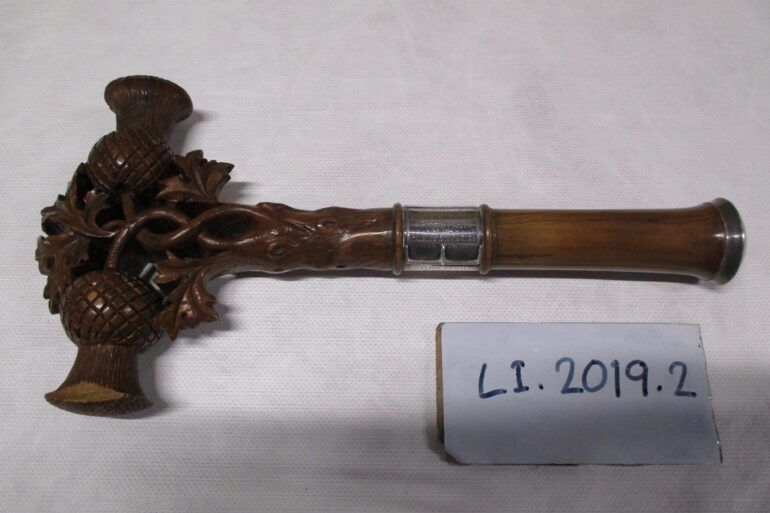The Burns Caup, presented to the Paisley Burns Club in 1814, is one of several ‘relics’ to remain in Paisley Museum’s store this year as the Club moves its traditional celebrations online.
The caup or cup, was originally presented to the Club by James Armour brother-in-law to Robert Burns and was frequently used by the poet for celebratory toasts. It is on permanent loan by the Paisley Burns Club to the museum, on the understanding that each year the caup, the original gavel used to call the proceedings, and the Club’s snuff box can be used at their annual dinner, and then returned to the museum for safekeeping and display.
Unfortunately COVID-19 restrictions have limited access to the museum’s collections this year, and in a break with tradition, the Club’s ‘relics’ will remain in the museum’s Secret Collection and will not be used.

Gavel, held by Renfrewshire Leisure on behalf of Paisley Burns Club. Image copyright of Renfrewshire Leisure
As well as local enthusiasm for his poems and songs, Burns is tied to Paisley through his wife Jean Armour who lived there for two months in 1786. She had been removed to the town by her father to avoid scandal as she was pregnant with Burns’ child and the couple only had an informal marriage agreement in place. Her brother James was admitted as an honorary member of the Paisley Burns Club in 1818 in ‘respect of his kindness’ in gifting the caup.
Paisley Burns Club was originally founded on 29 January 1805 at the behest of weaver-poet Robert Tannahill and is reputed to be the oldest club in the world. Having lapsed in members after 1836, it wasn’t until 1874 that it was fully revived. When the Club met again in 1875, almost 40 years later, it wasn’t weavers and friends of Tannahill who ran the proceedings, it was eminent townsmen including thread manufacturer Sir Peter Coats, historian David Semple, and artist James Elder Christie who was passionate about Burns and often attended as a guest.
Paisley Museum holds the largest collection of works by artist and Burns’ enthusiast James Elder Christie (1847-1914) in the world. He attended the meeting of the Paisley Burns Club when it was revived in 1875, and was a central figure in Burns’ celebrations in London in the 1870s. Christie was originally born in Fife and went to art school in Paisley. He was gregarious and moved in elite art circles, a founding member of Chelsea Arts Club and a member of the New English Art Club. He also founded the Paisley-Renfrewshire Society in London which was a celebration of all things Paisley (and by extension, of Scottish national heroes). Christie was by all accounts hugely passionate about the work of Robert Burns, and the immense power he showed in recitals of Tam O’Shanter and the Address to a Haggis awarded him the title of ‘brilliant interpreter’ and illustrator of Burns’ work.

Tam O’Shanter, James Elder Christie (1847–1914), Paisley Art Institute Collection held by Paisley Museum, Renfrewshire Leisure
Paisley Museum is part of the town’s radical regeneration plan, and the redesign of the campus is led by an international team including architects AL_A and exhibition designers Opera Amsterdam. When it reopens it is expected to attract over 125,000 visits each year and provide a £79 million economic boost to the area over the next 30 years.
Paisley Museum Reimagined is supported by Renfrewshire Council, the National Lottery Heritage Fund and the Scottish Government’s Regeneration Capital Grant Fund. The museum’s final phase of fundraising is now under way, with the museum website reimagined.paisleymuseum.org showcasing the project’s ambitious vision.

